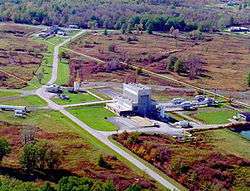Glenn Research Center
NASA John H. Glenn Research Center at Lewis Field is a NASA center, located within the cities of Brook Park and Cleveland between Cleveland Hopkins International Airport and the Rocky River Reservation of Cleveland Metroparks, with a subsidiary facility in Sandusky, Ohio. Its director is Marla E. Pérez-Davis. Glenn Research Center is one of ten major NASA facilities, whose primary mission is to develop science and technology for use in aeronautics and space. As of May 2012, it employed about 1,650 civil servants and 1,850 support contractors located on or near its site.
 | |
 Aerial view of Glenn Research Center at Lewis Field | |
| Agency overview | |
|---|---|
| Formed | 1942 |
| Preceding agencies |
|
| Jurisdiction | Federal government of the United States |
| Headquarters | Brook Park, Ohio, U.S. 41.412843°N 81.862399°W |
| Agency executive |
|
| Parent agency | NASA |
| Child agency |
|
| Website | www |
In 2010, the formerly on-site NASA Visitors Center moved to the Great Lakes Science Center in the North Coast Harbor area of downtown Cleveland.
History
The installation was established in 1942 as part of the National Advisory Committee for Aeronautics (NACA) and was later incorporated into the National Aeronautics and Space Administration as a laboratory for aircraft engine research.
It was first named the Aircraft Engine Research Laboratory after funding was approved in June 1940. It was renamed the Flight Propulsion Research Laboratory in 1947, the Lewis Flight Propulsion Laboratory (LFPL) in 1948 (after George W. Lewis, the head of NACA from 1919 to 1947), and the NASA Lewis Research Center in 1958.
On March 1, 1999, the center was officially renamed the NASA John H. Glenn Research Center at Lewis Field, in honor of John Glenn, who was a fighter pilot, astronaut (the first American to orbit the Earth) and a politician.
As early as 1951, researchers at the LFPL were studying the combustion processes in liquid rocket engines.[2]
Facilities
Plum Brook Field Station

The 6,400-acre (2,600 ha) Plum Brook Field Station near Sandusky, Ohio is also part of Glenn (41°20′59.4″N 82°39′01.8″W). It is located about 50 miles (80 km) from the main campus. It specializes in very large scale tests that would be hazardous on the main campus.[3]
As of 2015, the station consisted of five major facilities:[4]
- B-2 Spacecraft Propulsion Research Facility: not fully functional
- Combined Effects Chamber: never used and unusable
- Cryogenic Components Laboratory: slated for demolition
- Hypersonic Test Facility
- Space Power Facility
The Plum Brook Reactor was decontaminated and decommissioned under a 2008 cost-plus-fee contract valued at more than $33.5 million.[5]
The current US Senators from Ohio, Rob Portman and Sherrod Brown, have proposed to rename Plum Brook Station after Neil Armstrong.[6]
B-2 Spacecraft Propulsion Research Facility
The B-2 Spacecraft Propulsion Research Facility is the world's only facility capable of testing full-scale, upper-stage launch vehicles and rocket engines under simulated high-altitude conditions. The Space Power Facility houses the world's largest space environment vacuum chamber.[7]
Icing tunnel
An icing tunnel is capable of simulating atmospheric icing condition to test the effect of ice accretion on aircraft wings and body as well as to test anti-icing systems for aircraft.
Zero Gravity Research Facility
The Zero Gravity Research Facility is a vertical vacuum chamber used for microgravity experiments. It was designated a National Historic Landmark in 1985. The facility uses vertical drop tests in a vacuum chamber to investigate the behavior of components, systems, liquids, gases, and combustion in such circumstances.
The facility consists of a concrete-lined shaft, 28 feet (8.5 m) in diameter, that extends 510 feet (160 m) below ground level. An aluminum vacuum chamber, 20 feet (6.1 m) in diameter and 470 feet (140 m) high, is contained within the concrete shaft. The pressure in this vacuum chamber is reduced to 13.3 newtons per square meter (1.3×10−4atm) before use.
After the closing of the Japan Microgravity Centre (JAMIC), the NASA Zero-G facility is the largest microgravity facility in the world.
Another, smaller drop tower remains in use. That tower has a free fall time of 2.2 seconds, and the Dropping In Microgravity Environment (DIME) program is conducted there.
Significant developments
Aeronautics science and technology
NASA Glenn does significant research and technology development on jet engines, producing designs that reduce energy consumption, pollution, and noise. The chevrons it invented for noise reduction appear on many commercial jet engines today, including the Boeing 787 Dreamliner.
Space science and technology
The Glenn Research Center, along with its partners in industry, are credited with the following:
- The liquid hydrogen rocket engine, which Wernher von Braun credited as being the critical technology leading to the Apollo moon landing[8]
- The Centaur upper stage rocket[8]
- The gridded ion thruster, which is a high-efficiency engine for spaceflight.[9] A Glenn-derived ion engine was used on the successful NASA probe Deep Space 1.
- The Electrical Power System for Space Station Freedom, which, except for minor modifications, is used on the International Space Station.
Significant contributions
List of core competencies
NASA Glenn's core competencies are:[10]
- Air-breathing propulsion
- Communications technology and development
- Space propulsion and cryogenic fluids management
- Power, energy storage, and conversion
- Materials and structures for extreme environments
Education
The Glenn Research Center is home to the Lewis' Educational and Research Collaborative Internship Program (LERCIP).[11] It provides internships for high school and college students and high school teachers. The high school program is an eight-week internship for sophomores and juniors with interests in science, technology, engineering, math, or professional administration. The college level consists of a 10-week internship and is open to college students at all levels. Only residents of the Cleveland area are eligible for high school LERCIP, but college LERCIP is open to students nationwide. Interns work closely with their NASA mentors and are involved in the daily activities of the Center. They are expected to be available to work 40 hours a week for the duration of the internship. The LERCIP Teacher program is a 10-week internship for educators in STEM fields.
Other
The Dropping In Microgravity Environment is an annual contest held yearly by the center. Teams of high school students write proposals for experiments to be performed in the Drop Tower. The winners travel to the Center, perform their experiments, and submit a research report to NASA.
Future of Glenn
After 2004, NASA had been shifting its focus towards space exploration as mandated by the Vision for Space Exploration. Because of this, it was perceived by some that regional NASA centers like Glenn, which focus on research and technology, were becoming more and more marginalized in terms of resources and relevance.[12] However, on May 13, 2006, it was announced that NASA Glenn Research Center had secured management of the Crew Exploration Vehicle's service module, which promised to generate billions of dollars and hundreds of jobs for the center. This work secured the center's future in the near term, and signalled a shift in priority for the center from aeronautical research to space exploration, aligning itself closer with NASA's new mission.
Another change of direction created uncertainty in 2010, however, when President Obama and Congress declared the end of the Vision for Space Exploration and sought to chart a new course for human space flight and NASA. However, the 2015 budget for NASA made substantial increases to projects in which the Research Center participates, such as aeronautics research, planetary science and space technology, and some of that funding was expected to flow down to the Center.[13]
NASA Glenn Visitor Center
The NASA Glenn Visitor Center features six galleries with interactive exhibits about NASA, space exploration, John Glenn and other astronauts, satellites and the Solar System. The center also features an auditorium for lectures, movies and special programs, and a gift shop. Admission is free. Adult visitors must be U.S. citizens and present photo identification.
The NASA Glenn Research Center also offers public tours of its research facilities on the first Saturday of each month. Reservations must be made in advance.
The Visitor Center closed in September 2009 with many displays shifted to the Great Lakes Science Center, and new ones created there. This move was done to reduce the public relations budget and to provide easier access to the general public, especially the under-served community. It was hoped that putting the displays at the much more visited science center will bring the NASA Glenn facility more public exposure.[14] In fact, this proved true: compared to the 60,000 visitors per year at its former site, the Glenn Visitor Center enjoyed 330,000 visitors in the first year at the Great Lakes Science Center. The new display area at the science center is referred to as the Glenn Visitor Center.[15]
References
- Segall, Grant. "Marla Perez-Davis becomes acting director of NASA Glenn Research Center". cleveland.com. Retrieved 15 December 2019.
- "NACA TN-2349, Fluctuations in a spray formed by two impinging jets". National Advisory Committee for Aeronautics. Retrieved October 3, 2013.
- "NASA Glenn Test Facilities". National Aeronautics and Space Administration. Archived from the original on February 26, 2008. Retrieved October 3, 2013.
- Dan Leone (April 24, 2015). "NASA IG Scrutinizes Seldom-used Plum Brook Test Facilities". spacenews.com. Spacenews, Inc. Retrieved June 5, 2018.
- "NASA Awards Reactor Decontamination and Decommission Contract". NASA. May 29, 2008. Retrieved June 6, 2018.
- Sherrod Brown, Rob Portman want to rename Ohio NASA facility after Neil Armstrong Retrieved July 21, 2019
- "Plum Brook Station". NASA. Archived from the original on May 11, 2008. Retrieved October 3, 2013.
- Archived October 29, 2006, at the Wayback Machine
- "Glenn Ion Propulsion Research Tames the Challenges of 21st Century Space Travel". NASA. September 27, 2013. Archived from the original on September 15, 2007. Retrieved October 3, 2013.
- "Shaping the World of Tomorrow". nasa.gov. NASA. Retrieved December 25, 2017.
- "USA.gov". NASA. September 29, 2013. Retrieved October 3, 2013.
- "Northeast Ohio". Cleveland.com. Archived from the original on 2013-10-04. Retrieved 2013-10-03.
- Soder, Chuck (January 11, 2015). "Beefed-up budget is big development for NASA Glenn". Crain's Cleveland Business. Retrieved August 12, 2016.
- "Cleveland Plain Dealer | Cleveland, Ohio Newspaper". cleveland.com. Archived from the original on 2013-06-16. Retrieved 2013-10-03.
- "NASA Glenn visitors center offers its exhibits to Great Lakes Science Center". cleveland.com. 2009-07-15. Retrieved 2013-10-03.
External links
| Wikimedia Commons has media related to Glenn Research Center. |
- NASA.gov: official Glenn Research Center website
- NASA Glenn Visitor Center
- Engines and Innovation: Lewis Laboratory and American Propulsion Technology (NASA SP-4306, 1991)—The whole book, including photos and diagrams in on-line format.
- Historic American Engineering Record documentation, filed under Cleveland, Cuyahoga County, OH:
- HAER No. OH-124, "Rocket Engine Testing Facility, NASA Glenn Research Center", 14 photos, 12 measured drawings, 24 data pages, 3 photo caption pages
- HAER No. OH-132, "Altitude Wind Tunnel, NASA Glenn Research Center at Lewis Field", 120 data pages
- HAER No. OH-133, "Space Power Chambers, NASA Glenn Research Center at Lewis Field", 106 data pages
- HAER No. OH-134, "Altitude Wind Tunnel Support Buildings, NASA Glenn Research Center at Lewis Field", 93 data pages
- HAER No. OH-136, "Glenn Research Center, Propulsion Systems Laboratory No. 1 and 2, John H. Glenn Research Center, 21000 Brookpark Road", 137 data pages
